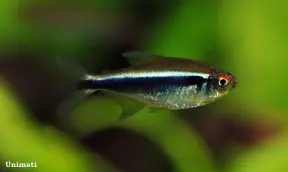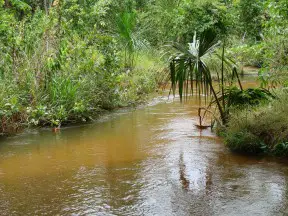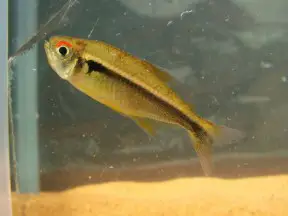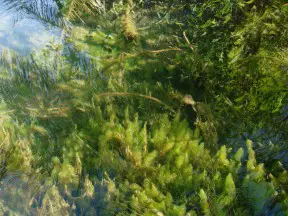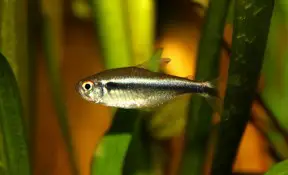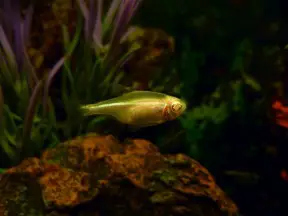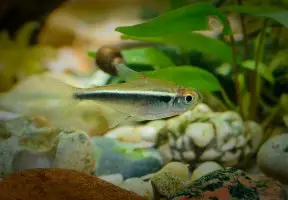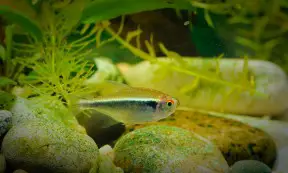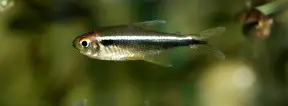Hyphessobrycon herbertaxelrodi
Black Neon Tetra
Etymology
Hyphessobrycon: from the Ancient Greek υπελάσσων (hyphesson), meaning ‘of lesser stature’, used as a prefix in this case, plus the generic name Brycon.
herbertaxelrodi: named for American author, publisher, and entrepreneur Dr. Herbert R. Axelrod (1927 – ).
Classification
Order: Characiformes Family: Characidae
Distribution
This species appears to be widespread throughout the upper rio Paraguai in the states of Mato Grosso and Mato Grosso do Sul, Brazil, both north and south of the the vast tropical wetland known as the Pantanal.
Official records seem limited, but the type locality is located within the upper rio Taquari basin in the municipality of Coxim, while our field images show a specimen collected from the upper rio Sepotuba in the vicinity of Tangará da Serra, some 700 kilometers to the north. The Sepotuba empties into the Paraguai main channel around 500 kilometres upstream of the Taquiri, thus the species is assumed to occur in other drainages between them.
Many of the fish species inhabiting the upper Paraguai and Panatanal region also occur in the upper rio Guaporé, known as Iténez in Bolivia, basin. The latter also has its headwaters in the Pantanal but flows in the opposite direction to the Paraguai and is part of the upper rio Madeira basin, itself a major tributary within the Amazon drainage, with the two watersheds connected due to rising water levels during the annual wet season. Records of a fish identified as H. cf. herbertaxelrodi from Noel Kempff Mercado National Park in the upper Guaporé, at the border between Bolivia and Brazil, suggest that it might also share this pattern of distribution.
The species has also been introduced into natural waters of Minas Gerais in southeastern Brazil via the ornamental trade, with at least one feral population established in the rio Paraíba do Sul basin
Type locality is ‘Coxim on the Rio Taquary [= Taquari], Rio Paraguay [= Paraguai] basin, Mato Grosso, Brazil’.
Habitat
Appears to favour minor tributaries, headwater rivers, oxbows, and seasonally inundated floodplains.
For example, it has been collected from small streams draining to the upper rio Sepotuba in Mato Grosso state, itself a tributary of the upper rio Paraguai. These comprise flowing tributaries measuring a few metres wide with clear, light brown water and thick marginal vegetation. In some places aquatic macrophytes, including members of the genera Eleocharis, Echinodorus and Echinoria, also grow densely.
Sympatric fish species in the Sepotuba watershed include Astyanax assuncionensis, Creagrutus meridionalis, Knodus chapadae, Moenkhausia dichroura, Serrapinnus calliurus, Odontostilbe pequira, Pyrrhulina australis, Characidium aff. zebra, Leporinus friderici, Hoplias malabaricus, Farlowella paraguayensis, Rineloricaria cacerensis, Otocinclus sp., Corydoras aff. aeneus, Aequidens plagiozonatus, Crenicichla cf. lepidota, Gymnotus inaequilabiatus, Rivulus aff. picturatus, and Synbranchus marmoratus.
In the Pantanal small characids are often found in extremely clear water where submerged vegetation proliferates. The wetland is rich in aquatic macrophytes with at least 280 species recorded, including members of genera popular in the aquarium hobby such as Echinodorus, Bacopa, Ludwigia, Sagittaria, Eleocharis, and Salvinia.
Maximum Standard Length
30 – 35 mm.
Aquarium SizeTop ↑
An aquarium with base dimensions of 80 ∗ 30 cm or equivalent should be the smallest considered.
Maintenance
Perhaps looks best in an arrangement comprising a sandy substrate plus some driftwood roots and branches, or heavily-planted planted set-up.
The addition of dried leaf litter would further emphasise the natural feel and as well as offering additional cover for the fish brings with it the growth of microbe colonies as decomposition occurs.
The latter are useful since they provide an additional food source for both adults and fry while the humic substances released by decaying leaves are also considered beneficial.
Water Conditions
Temperature: 20 – 28 °C
pH: 5.0 – 7.5
Hardness: 18 – 215 ppm
Diet
Likely to be omnivorous feeding on small invertebrates, crustacea, filamentous algae, fallen fruit and suchlike in nature.
In aquaria it may survive on a diet of dried foods but like most fishes does best when offered a varied menu which in this case should also contain live and frozen chironomid larvae (bloodworm), mosquito larvae, Daphnia, Moina, etc.
Behaviour and CompatibilityTop ↑
Very peaceful making it an ideal resident of the well-researched community aquarium.
It is best-maintained alongside similarly-sized characids, gasteropelecids, lebiasinids, smaller callichthyid or loricariid catfishes and non-predatory, small-to-medium-sized cichlids.
Try to buy a mixed-sex group of at least 8-10 specimens, include other schooling fishes to provide security, and you will be rewarded with a more natural-looking spectacle.
Sexual Dimorphism
Sexually mature females are noticeably deeper-bodied and a little larger than males.
Reproduction
An egg-scattering free spawner exhibiting no parental care.
When in good condition adults will spawn often and in a mature aquarium it is possible that small numbers of fry may start to appear without intervention, but if you want to maximise yield a more controlled approach is required.
The adult group can still be conditioned together but a smaller aquarium should also be set up and filled with mature water. This should be very dimly lit and the base covered with some kind of mesh of a large enough grade so that the eggs can fall through but small enough so that the adults cannot reach them. The widely available plastic ‘grass’-type matting can also be used and works well, as does a layer of glass marbles. Alternatively, filling much of the tank with a fine-leaved plant such as Taxiphyllum spp. or spawning mops can also return decent results.
The water itself should be of slightly acidic to neutral pH with a temperature towards the upper end of the range suggested above. An air-powered sponge filter or air stone(s) should also be included to provide oxygenation and water movement.
When the adult fish are well-conditioned a single pair or group comprising one or two males and several females can then be introduced to each container and left in place until eggs are detected (typically the following morning).
Initial food should be Paramecium or a proprietary dry food of sufficiently small (5-50 micron) grade, introducing Artemia nauplii, microworm, etc., once the fry are large enough to accept them.
NotesTop ↑
This species has been a ubiquitous aquarium fish since its discovery, and is produced on a commercial basis in several countries, therefore wild fish are no longer collected. An ornamental albino form is sometimes available.
Apart from its distinctive colour pattern, it can be identified from related species via the following combination of characters as per Géry (1977): body depth fits less than 3.6 times in SL; maxilla fits 3.4-3.5 times in HL; caudal peduncle length usually fits 1.2-1.4 times in SL; usually 9-10 predorsal scales; 32-34 longitudinal scales.
H. herbertaxelrodi is typically included in the putative ‘H. agulha-group’ of closely-related species within the genus as proposed by Géry (1977), of which all members possess a dark lower half of the body, especially above the anal-fin, and usually a horizontally elongate humeral spot, more or less united with the asymmetrical, broad band. Other species in this group include H. agulha, H. loretoensis, H. metae, and H. peruvianus, although some authors have included one or more of these, including H. herbertaxelrodi, in the related H. heterohabdus group.
Lima et al. (2014) noted similarities between the H. aghula group and their revised H. heterorhabdus group which comprises Hyphessobrycon heterorhabdus, H. amapaensis, and H. eschwartzae. This trio all possess: a well-defined, elongate humeral blotch which is continuous with a dark, well-defined midlateral stripe that becomes blurred towards the caudal peduncle; a longitudinal red stripe extending along the body above the midlateral line; upper half of the eye red.
This pattern is different to that presented by several members of Géry’s original H. heterorhabdus group, such as H. vilmae, H. cachimbensis, and H. stegemanni, which possess a continuous, solid dark lateral stripe on the body and no obvious humeral blotch.
Hyphessobrycon was raised by Durbin in Eigenmann (1908) as a subgenus of Hemigrammus, differing from the latter by the absence of scales on the caudal-fin.
The grouping was revised by Eigenmann (1918, 1921) while Géry (1977) created artificial groups of species based on colour pattern, and these definitions are still widely used today, e.g., the H. agulha group, the H. heterohabdus group, etc. These cannot be considered to represent monophyletic assemblages, however, and their concepts continue to be redefined.
Weitzman & Palmer (1997) hypothesised the existence of a monophyletic assemblage within the genus based on colour pattern and male fin morphology that they termed the ‘rosy tetra clade’, with one of the characters supporting its monophyly being presence of a prominent dark marking on the dorsal-fin. This assemblage, plus other morphologically similar species, is considered to represent Hyphessobrycon sensu stricto by some authors, with the remaining species included in a much-expanded H. heterohabdus group.
Others have proposed conflicting, typically more restricted, views of both the genus and/or its constituent species groups, and significant confusion remains. What is clear is that, as currently recognised, Hyphessobrycon is a polyphyletic lineage containing several genera.
The process of splitting it up has already started, and Malabarba et al. (2012) revalidated the genus Ectrepopterus Fowler, previously considered a synonym of Hyphessobrycon. They also analysed its relationships within the Characidae in the context of Mirande’s (2010) previous work, but included the type species, H. compressus, for the first time in such a study. The results demonstrated that H. compressus is more closely-related to ‘rosy tetra’ representatives such as H. eques, H. pulchripinnis, and H. socolofi than other members of the genus including H. anisitsi, H. bifasciatus, H. elachys, H. herbertaxelrodi, and H. luetkeni.
References
- Géry, J. , 1961 - Tropical Fish Hobbyist 9(9): 26-46
Three new South-American characids. - Calcagnotto, D., S. A. Schaefer, and R. DeSalle, 2005 - Molecular Phylogenetics and Evolution 36(1): 135-153
Relationships among characiform fishes inferred from analysis of nuclear and mitochondrial gene sequences. - Chernoff, B., A. Machado Allison, P.Willink, J. Sarmiento, S. Barrera, N. Menezes, and H. Ortega, 2000 - Interciencia 25(6): 273-283
Fishes of three Bolivian rivers: diversity, distribution and conservation. - de Magalhães, A. L. B. and P. A. de Carvalho, 2007 - Natureza & Conservação 5(2): 124-129
Occurrence of exotic ornamental fish in streams in the states of Minas Gerais and Rio de Janeiro, Brazil. - Géry, J., 1977 - T. F. H. Publications, Inc.: 1-672
Characoids of the world. - Lima, F. C. T., D. P. Coutinho and W. B. Wosiacki, 2014 - Zootaxa 3872(2): 167-179
A new Hyphessobrycon (Ostariophysi: Characiformes: Characidae) from the middle Amazon basin, Brazil. - Malabarba, L. R., V. A. Bertaco, F. R. Carvalho & T. O. Litz., 2012 - Zootaxa 3204: 47-60
Revalidation of the genus Ectrepopterus Fowler (Teleostei: Characiformes), with the redescription of its type species, E. uruguayensis. - Mirande, J. M., 2010 - Neotropical Ichthyology 8(3): 385-568
Phylogeny of the family Characidae (Teleostei: Characiformes): from characters to taxonomy. - Oliveira, C. A., G. S. Avellino, K. T. Abe, T. C. Mariguela, R. C. Benine, G. Orti, R. P. Vari, and R. M. Corrêa e Castro, 2011 - BMC Evolutionary Biology 11(1): 275-300
Phylogenetic relationships within the speciose family Characidae (Teleostei: Ostariophysi: Characiformes) based on multilocus analysis and extensive ingroup sampling. - Reis, R. E., S. O. Kullander and C. J. Ferraris, Jr. (eds), 2003 - EDIPUCRS, Porto Alegre: i-xi + 1-729
Check list of the freshwater fishes of South and Central America. CLOFFSCA. - Zarske, A., 2014 - Vertebrate Zoology 64(2): 139-167
Zur Systematik einiger Blutsalmler oder "Rosy Tetras" (Teleostei: Ostariophysi: Characidae). - Zarske, A. and J. Géry, 2004 - Zoologische Abhandlungen; Staatliches Museum für Tierkunde in Dresden 54: 31-38
Hyphessobrycon nigricinctus sp. n. -- ein neuer Salmler (Teleostei: Characiformes: Characidae) aus dem Stromgebiet des río Madre de Dios in Peru.
